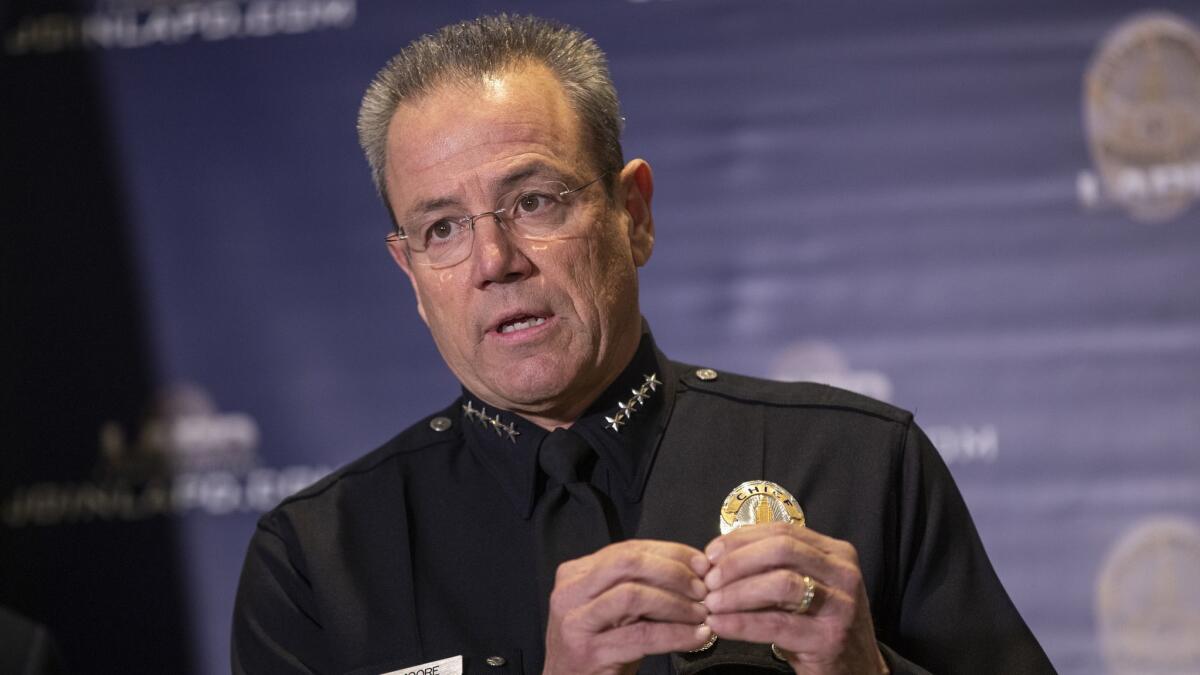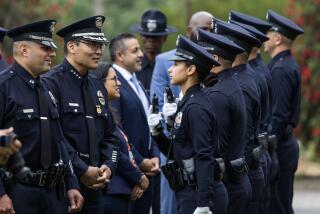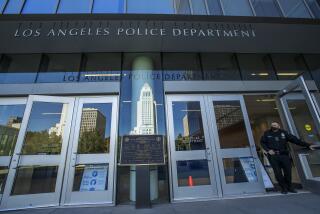LAPD to dramatically downsize special units, focus on patrol as budget cut shrinks force

- Share via
The Los Angeles Police Department in coming months will downsize its specialized units and stop responding in person to traffic collisions and other minor incidents as part of a broad reorganization aimed at preserving patrol and community engagement functions amid new fiscal constraints.
Although specific figures weren’t available Friday, the reshuffling will reduce the size of the vaunted but troubled Metropolitan Division, as well as cut the air support, robbery and homicide and gang and narcotics divisions. The department also will reduce desk hours at its stations, cut special deployments in popular areas such as Venice and Hollywood, and stop staffing teams that cover homelessness issues.
A total of 234 officers will move back into patrol. Station desks will be manned only during weekday hours. Victims of misdemeanor hit-and-run crashes and collisions with minor injuries will be advised to file a report online.
“We need to offload a number of responsibilities,” said LAPD Chief Michel Moore in an interview with The Times Friday.
The plans — which Moore said protect the department’s core patrol mission and its newly expanded Community Safety Partnership program — come after the City Council cut the department’s multibillion-dollar budget by $150 million in the face of widespread protests this summer, and amid a pandemic-driven fiscal crisis that could see funding for police and other city agencies dry up further as the year progresses.
They also come as homicides and shootings soar to levels not seen in the city in a decade, ratcheting up concerns in some communities that the changes could cost lives. Homicides are up by about 25% this year, compared with last, putting the city on pace to surpass 300 killings for the first time since 2009.
More broadly, the cuts represent a new trajectory for one of the largest and most scrutinized police agencies in the country — and reflect how fully it has been forced to bend to the “Defund Police” movement, which garnered attention and momentum this summer when activists and other protesters rallied in massive numbers in the streets and barraged local elected officials with demands in person and during virtual Zoom meetings.
Moore said the $150-million budget cut — historic but far short of what activists had demanded — presented a “tremendous challenge” to the LAPD, forcing it to cut 350 sworn positions and reducing its ranks from about 10,110 sworn officers to an estimated 9,752 by March or April. Many more civilian employees will be lost.
The reductions will come through retirements, not from closing out vacant positions, meaning they are “a true cutback” in force and not simply “phantom vacancies” remaining unfilled, Moore said.
In response, Moore requested input from commanders throughout the department on how to restructure the department in light of the new budget, and with their input drafted the above plan. He said he is now discussing the changes with the union that represents rank-and-file LAPD officers.
The city’s collective bargaining agreement with the Los Angeles Police Protective League may limit how Moore can shuffle officers, but Moore said the general thrust of his proposed shakeup is unlikely to change.
What the impact will be in Los Angeles is not immediately clear — and far from agreed upon.
Craig Lally, president of the police union, said his group plans to engage with Moore to make sure the cuts and transfers of officers are “done in a fair and transparent way” for officers — but that the changes will be a “catastrophe for the safety” of Angelenos at a time of intense violence.
“These cuts can’t come at a worse time, and our neighbors will be less safe. It’s going to be catastrophic,” he said. “There’s nothing good that’s going to come out of this, and it’s only going to get worse. This is just the tip of the iceberg.”
Melina Abdullah, co-founder of the Los Angeles chapter of Black Lives Matter, said protesters and activist groups who fought for the LAPD budget reduction welcome having fewer officers on the streets, especially if it means fewer interactions between police and people suffering from mental illness or homelessness.
“We do want to see cuts to LAPD, especially around those areas that they don’t have the expertise to handle,” Abdullah said.
At the same time, Abdullah said she viewed Moore’s plan as “a first step” that “doesn’t go nearly far enough” in redirecting police funding to “the things that actually create safe communities,” which she said include community-based intervention and prevention workers and recreation programs.
To date, Abdullah said she has not seen the city invest any of the money it saved by cutting the police budget back into the community, but her group intends to provide a list of things it would like to see funded in coming weeks.
Peter Moskos, a former officer and professor at the John Jay College of Criminal Justice in New York, said the impact of changes to policing in major cities can be hard to immediately detect in crime trends.
A recent analysis by The Times found that, of nearly 18 million calls logged by the LAPD since 2010, less than 8% — or about 1.4 million — were for reports of homicides, assaults with deadly weapons, robberies, batteries, shots fired and rape. Police responded to a greater number of traffic accidents and “minor disturbances.”
Still, “there’s no way policing will get better with less money,” Moskos said, and “people should be concerned” that the LAPD changes are coming at a time when violence has increased so dramatically.
If crime does increase, the impacts will “reverberate” across the city, he said, including as trauma suffered by victims of violence in communities most heavily impacted by it, which are disproportionately communities of color.
Moskos said the reduction in the number of officers also could backfire in a fiscal way if emergencies force the LAPD to call in — and therefore pay overtime to — a large number of officers. That would undercut an effort by the department to rein in overtime as another cost-saving measure.
Moore said he agrees with protesters and local politicians that police should not be frontline responders in situations involving mental illness, homelessness or minor traffic incidents, and his intention is to start carving out more areas of crisis response in the city where the police play no role.
But he’s had mixed results in trying to find replacement agencies or organizations to handle those incidents, he said.
The transportation department, facing its own fiscal pressures, has rejected the idea of its personnel responding to collisions instead of police, Moore said. A program backed by Mayor Eric Garcetti’s office and Los Angeles County officials in which unarmed crisis teams will be dispatched to some nonviolent 911 calls may help reduce the need for officers, but Moore said the overall shift of police duties to other entities is “not going fast enough and it’s not going deep enough.”
Moving forward, the LAPD will “continue to identify calls that we are no longer going to respond to,” as it looks for “other agencies and organizations to hand that baton to,” Moore said.
In the meantime, he said he hopes his efforts to protect patrol will empower commanders in each of the city’s 21 geographic areas to “manage the most pressing public safety needs there” with the resources they have.
Moore said that officer education and oversight, including anti-bias and de-escalation training and internal affairs investigations, will not be impacted.
Alex Comisar, a spokesman for Garcetti, said the city is “reimagining” public safety along with community leaders, and Garcetti “trusts the LAPD’s ability to make the operational changes necessary to keep our city safe, and help us meet this moment in partnership with all Angelenos.”
More to Read
Sign up for Essential California
The most important California stories and recommendations in your inbox every morning.
You may occasionally receive promotional content from the Los Angeles Times.











